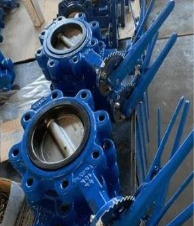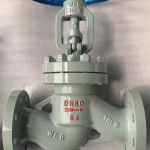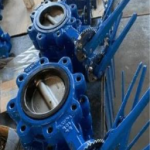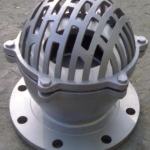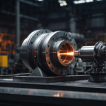Wafer vs Lug Butterfly Valve: What’s the Difference?
Butterfly valves are utilized extensively across various industries for regulation of flow as well as for isolation of fluid. Due to their small size, quick actuation, and low cost, they are highly used in a wide range of applications from chemical processing to water treatment. Wafer and lug-type butterfly valves are most commonly used among a wide range of butterfly valve types.
Even though both styles consist of a circular disc and provide the same basic function, they are quite different in installation, use, price, and upkeep. In this blog, we’ll take you through the key differences between wafer and lug butterfly valves so you can pick the best one for your particular application.
At SVR, we provide a full range of wafer and lug butterfly valves designed to withstand rigorous operation conditions with precision and quality.
What is a Wafer Butterfly Valve?
A wafer butterfly valve is intended to be inserted between two flanges within a piping system. It lacks bolt holes protruding out of it; rather, it uses extended bolts that go through the pipe flanges as well as the valve body to secure it all together.
Key Characteristics:
- Lightweight compact.
- Mainly used for on/off and modulating service.
- Is mostly used in systems where space is confined.
- Wafer-type butterfly valves seal well, even against bidirectional pressure, and are normally less costly than lug types.
What is a Lug Butterfly Valve?
A lug butterfly valve is a projecting-lugged (threaded insert) body on either end. Lugs are reverse bolt holes on adjacent pipe flanges. Each flange bolts separately to the valve, so one half of the piping can be isolated without affecting the other.
Key Features:
- Compatible for dead-end application (used in the piping end termination).
- Less versatile than wafer designs in terms of installation.
- Heavy-duty and more robust than wafer models.
- Lug-type butterfly valves are best to use where piping shutdown and break are required.
Major Differences Between Wafer and Lug Butterfly Valves
For easier description of the same, let us compare their differences in detail below:
- Fitting Method
Wafer Type:
- Between two sandwiched flanges.
- Long bolts holding across pipe flanges.
- No threaded holes on valve body.
Lug Type:
- Individually bolted on either side to pipe flanges.
- Valve body threaded with lugs.
- Can be used to isolate pipe sections.
Lug valves are more convenient at the time of installation, particularly when it is required to break half of the piping.
- Maintenance and Accessibility
Wafer Type:
- Maintenance requires removal of entire valve.
- Not suitable if piping on one side has to continue running.
Lug Type:
- One side of the pipe can be broken out without stopping the other.
- Easier to maintain or replace in separated piping systems.
Lug valves are better in maintenance accessibility and isolation capability.
- Strength and Application Suitability
Wafer Type:
- Captive for regular service where the pipe is not to be completely isolated.
- Dead-end service is not suitable for it.
Lug Type:
- More stress-resistant because it has independent bolting.
- Can be dead-ended with suitable pressure ratings.
Lug valves are stronger and more appropriate for critical applications.
- Cost and Weight
Wafer Type:
- Less weight and less costly.
- Less initial and installation cost.
Lug Type:
- Heavy and generally more costly because of increased material and machining.
- More installation and maintenance cost.
Wafer valves are cost-saving and lighter, ideal for cost-saving installations.
- Flow Characteristics
Wafer and lug butterfly valves have identical internal disc design and similar flow control properties. The lug valves, however, will add an imperceptible little bit more resistance with their more substantial body and design, but this is minimal in typical common applications.
Summary: Wafer vs Lug Butterfly Valve
| Feature | Wafer Butterfly Valve | Lug Butterfly Valve | ||||
| Between flanges | Bolted to each flange | ||||
| No threaded holes | Threaded lugs | ||||
| Limited | High (can isolate one side) | ||||
| Not suitable | Suitable | ||||
| Requires full removal | One side can be removed | ||||
| Lower | Higher | ||||
| Lighter | Heavier | ||||
| General flow control | Critical systems, isolation | ||||
Advantages and Disadvantages:
Wafer Butterfly Valve Advantages:
- Light and cost-effective.
- Easy to install between flanges.
- Good for low-pressure systems and narrow spaces.
Disadvantages:
- Cannot shut off one side of the system.
- Not ideal for dead-end service.
Lug Butterfly Valve Advantages:
- Permits one-sided pipeline shutdown.
- Best suited for dead-end service.
- Stronger and longer-lasting.
Disadvantages:
- Heavy and costly.
- More intricate setup process.
Application Suitability
Let’s look at where each valve type suits:
Wafer Butterfly Valve – Best for:
- HVAC systems
- Water distribution
- Fire protection systems
- Space-limited compact installations
Lug Butterfly Valve – Best for:
- Chemical processing facilities
- Oil and gas pipelines
- Wastewater treatment
- Systems that require frequent maintenance or section isolation
Which One to Choose?
The choice between a wafer and lug butterfly valve depends on your system requirements:
- Use a wafer butterfly valve if you require an affordable, space-conserving general flow control solution.
- Use a lug butterfly valve if your system must be line isolated, dead-ended, or accessible for easy maintenance.
We offer top-quality wafer and lug butterfly valves meticulously designed, durable to test, and built in alignment with your precise business specifications at SVR Company. You may want selection guidance by such specifications as pressure class, fluid or gas suitability, and assembly information by our technicians.
Whereas both wafer and lug butterfly valves operate at their core, the differences in design are what are ultimately responsible for determining their best applications. Wafer valves are sleek, light, and less expensive, yet lug valves are more versatile, isolated, and resilient.
Need expert advice? Get in touch with SVR today and have our valve experts guide you in choosing the best valve solution for your project.

